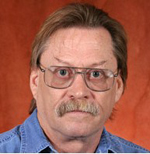

Interview with Mike Davidson

Michael W. Davidson is currently an Assistant Scholar / Scientist at the National High Magnetic Field Laboratory of the Florida State University. Amongst various other publications and scientific contributions, he started the popular optics and microscopy educational site called Molecular Expressions™.
IDEX Health & Science: You are most well known for your expertise in optical microscopy, especially fluorescence imaging; however, you are based out of the National High Magnetic Field Laboratory at Florida State University. Could you share the connection?
Mike Davidson: Actually I was working for the center for materials research here at FSU doing microscopy, when we got the Mag Lab grant back in 1990 and so I just moved to the new building when it was built. Over the years I have done custom microscopy for investigators at the lab and my group has contributed to graphics for the Mag Lab; we have also built several websites. Therefore I have been integrated into a lot of functions here. Like I said, I have been here for two decades now.
IDEX Health & Science: Molecular Expressions™ is a valuable educational website for the fluorescence imaging community. What was the original motivation behind this website?
Mike Davidson: Well, originally back in the early 1990’s and even before the HTT protocol (HTTP) was developed we were licensing images that we had made through the microscope of cocktails, vitamins, computer chips (and) of other types of things too. Commercial entities were marketing them. So we made a lot of money with “Neckties”, actually several million (dollars), which generated a lot of royalties for us. I started the (Molecular Expressions) website for two purposes: one was to advance the computer skills and capabilities of my laboratory, and the second was to try to market the images. After a few years of doing that, back in the 1998, I started on the Microscopy Primer (because I) thought that was a good addition to the website. And then I got royalties to help, then eventually Nikon and Olympus entered into license agreements for us to build individual sites for them.
IDEX Health & Science: Also even though you are in academia, you have a very unique relationship with the industry folks. For example, you actively collaborate with numerous companies involved in making equipment for microscopy in order to develop educational material. Could you say a few words about the advantages as well as challenges of this unique academia-industry relationship?
Mike Davidson: Well, I actually have a pretty close relationship with three of the four microscope companies, most of the camera manufacturers, the filter companies, (and) we have worked with Molecular Probes® to develop samples. Additionally, I have a lot of collaborations with other companies in the biotech industry that make fluorophores, antibodies, and after-market products. The upside is that we can get equipment at reduced cost or free of charge, but the downside is that we have to often do a lot of developmental work for our partners. Sometimes it is good and sometimes it is bad. For the most part it is a good deal for us because (for example) with the filter companies we can shoot images of our routine samples with their filters and share the images with them. With the microscope companies we need the microscopes to build the websites for those companies; with the camera companies we share images and videos. So it works out good for us for the most part.
IDEX Health & Science: During last few years, you have been publishing a series of articles on “Pioneers in Optics”. Could you talk about this interesting series of articles?
Mike Davidson: “Pioneers in Optics” is really a part of our K-12 educational section on Molecular Expressions where we basically try to introduce kids to optics and microscopy. The Pioneers in Optics section was simply a historical spin on the different contributors to optics and microscopy over the years. It is really designed just to be a reference educational site for high school for K-12. We have a section on Molecular Expressions called Science, Optics & You and that is where it is housed. There is a lot of lower level introductory tutorial and there is information on some of the educational microscopes such as Intel Play QX3 and QX5. But, I have intertwined it (Pioneers in Optics) throughout the website and there are links to it throughout the website.
IDEX Health & Science: Super-resolution microscopy is currently a hot field. Amongst various super-resolution imaging techniques, PALM (Photoactivated Localization Microscopy) was a seminal contribution to the field of fluorescence microscopy. How did this technique come to fruition?
Mike Davidson: PALM was the brain child of Eric Betzig and Harald Hess. I was introduced to them by the director of the Mag Lab, Greg Boebinger, a couple of years before the PALM paper came out when they were actually looking for jobs. They had both had outstanding careers at the Bell Labs but had subsequently retired. Greg was thinking about hiring them here, but I couldn’t contribute because I did not have the necessary funding. Eric and Harald weren’t really interested in doing the type of physics that Mag Lab needs and they ultimately went to Janelia Farms--a much better fit for their talents. Before that we started taking about some of Eric Betzig’s ideas on high resolution microscopy: things like optical lattice microscopy and other brilliant ideas. Eric and Harald came down here to visit one time and they had this idea for PALM. They described to me how it would work – very simplistic and very brilliant. I would never have thought of this on my own. What they needed for PALM was photo-convertible probes. They were thinking about using caged fluorophores, which can be very difficult to get and I recommended fluorescent proteins – the optical highlighter fluorescent proteins. And that’s where we got involved. We actually made samples for them – during research that led to the Science paper.
IDEX Health & Science: I’m sure many people are curious how you are able to fund these very practical and very large projects where you develop and characterize the “tools” for advancing biological knowledge, such as fluorescent proteins themselves as well as the hardware and software for microscopy.
Mike Davidson: We fund these things through commercial contracts and also sometimes one-off commercials and also licensing. So we have an active business of licensing images. We have contracts with our commercial partners: Nikon, Zeiss, Olympus, Hamamatsu and Invitrogen. These license fees for the websites that we build pay for the technicians that work in the laboratory. We pay for the expenses out of royalties and basically it is good for both of us because I get the work done, I am able to build the websites and the money that Nikon, Olympus and Zeiss pay for royalties goes into directly building their respective websites--not for profit.
